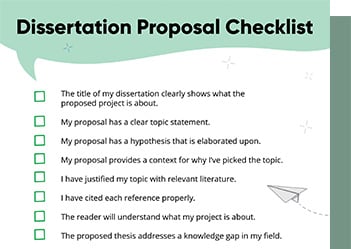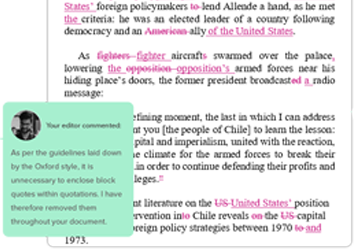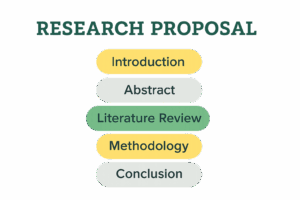- Tips to Self-Edit Your Dissertation
- Guide to Essay Editing: Methods, Tips, & Examples
- Journal Article Proofreading: Process, Cost, & Checklist
- The A–Z of Dissertation Editing: Standard Rates & Involved Steps
- Research Paper Editing | Guide to a Perfect Research Paper
- Dissertation Proofreading | Definition & Standard Rates
- Thesis Proofreading | Definition, Importance & Standard Pricing
- Research Paper Proofreading | Definition & Standard Rates
- Essay Proofreading | Options, Cost & Checklist
- Top 10 Paper Editing Services of 2024 (Costs & Features)
- Top 10 Essay Checkers in 2024 (Free & Paid)
- Top 10 English Correctors to Perfect Your Text in 2024
- 10 Advanced AI Text Editors to Transform Writing in 2024
- Personal Statement Editing Services: Craft a Winning Essay
- College Essay Review: A Step-by-Step Guide (With Examples)
- Top 10 College Essay Review Services: Pricing and Benefits
- How to Edit a College Admission Essay (8-Step Guide)
- Improve Academic Writing: Types, Tips, Examples, Services
- How to Use AI to Write Research Papers: A Step-by-Step Guide
- How to Write an Assignment: A Step-by-Step Guide for Students
- AI Proofreading Services: Meaning, Benefits & Best Tools
- 10 Best Proofreading Services Online for All in 2025
- Top 10 Recommendation Letter Editing Services | Best Picks
- How to Format an Appendix: APA and MLA
- Top 10 Online Thesis Editing and Proofreading Services
- What is Academic Editing? Meaning, Types & Importance
- Top 10 AI Proofreaders to Perfect Your Writing in 2025
- What Is a Thesis: How to Write a Thesis with Examples
- Top 10 Academic Proofreading Services (2025 Update)
- Research Paper Outline: Free Templates & Examples to Guide You
- How to Write a Research Paper: A Step-by-Step Guide
- How to Write a Lab Report: Examples from Academic Editors
- Research Methodology Guide: Writing Tips, Types, & Examples
- The 10 Best Essential Resources for Academic Research
- 100+ Useful ChatGPT Prompts for Thesis Writing in 2024
- Best ChatGPT Prompts for Academic Writing (100+ Prompts!)
- Sampling Methods Guide: Types, Strategies, and Examples
- Independent vs. Dependent Variables | Meaning & Examples
- Understanding Verbatim Plagiarism: Copy, Paste, Regret
- What Is a Journal Article and How to Write a Journal Article
- How to Use AI to Write Research Papers: A Step-by-Step Guide
- Top 10 AI Tools for Research in 2025 (Fast & Efficient!)
- What Is a Research Proposal: A Detailed Guide
- How to Format an Appendix: APA and MLA
- What Is an Appendix In a Paper?
- Types of Journals in Research and Their Features
- How to Write a Research Proposal (Step-by-Step)
- How to Cite an Artwork: APA, MLA, & Chicago
- Difference Between Paper Editing and Peer Review
- How to Handle Journal Rejection: Essential Tips
- Editing and Proofreading Academic Papers: A Short Guide
- How to Carry Out Secondary Research
- The Results Section of a Dissertation
- Final Checklist: Is My Article Ready for Submitting to Journals?
- Types of Research Articles to Boost Your Research Profile
- How does LaTeX based proofreading work?
- How to Improve Your Scientific Writing: A Short Guide
- Chicago Title, Cover Page & Body | Paper Format Guidelines
- How to Write a Thesis Statement: Examples & Tips
- Chicago Style Citation: Quick Guide & Examples
- Research Paper Outline: Free Templates & Examples to Guide You
- The A-Z Of Publishing Your Article in A Journal
- What is Journal Article Editing? 3 Reasons You Need It
- How to Cite a Book in APA Style | Format & Examples
- How to Start a Research Paper | Step-by-step Guide
- APA Citations Made Easy with Our Concise Guide for 2024
- A Step-by-Step Guide to APA Formatting Style (7th Edition)
- Academic Writing in 2024: 5 Key Dos & Don’ts + Examples
- How to Write a Lab Report: Examples from Academic Editors
- What Are the Standard Book Sizes for Publishing Your Book?
- MLA Works Cited Page: Quick Tips & Examples
- 2024’s Top 10 Thesis Statement Generators (Free Included!)
- Top 10 Title Page Generators for Students in 2024
- What Is an Open Access Journal? 10 Myths Busted!
- Primary vs. Secondary Sources: Definition, Types & Examples
- How To Write a College Admissions Essay That Stands Out
- APA Journal Citation: 7 Types, In-Text Rules, & Examples
- What Is Predatory Publishing and How to Avoid It!
- Independent vs. Dependent Variables | Meaning & Examples
- How to Write a Strong Dissertation & Thesis Introduction
- How to Cite a Book in MLA Format (9th Edition)
- How to Cite a Website in MLA Format | 9th Edition Rules
- 10 Best AI Conclusion Generators (Features & Pricing)
- Top 10 Academic Editing Services of 2024 [with Pricing]
- How to Create the Perfect Thesis Title Page in 2024
- What Is Accidental Plagiarism & 9 Prevention Strategies
- What Is Self-Plagiarism? (+ 7 Prevention Strategies!)
- Understanding Verbatim Plagiarism: Copy, Paste, Regret
- Improve Academic Writing: Types, Tips, Examples, Services
- What Is a Journal Article and How to Write a Journal Article
- What Is Paraphrasing Plagiarism and How to Avoid It
- What Is Expository Writing? Types, Examples, & 10 Tips
- Academic Research Ethics & Rules Simplified for All
- Complete Guide to MLA 9th Format
- Top 10 Online Dissertation Editing Services of 2025
- How to Write a Dissertation & Thesis Conclusion (+ Examples)
- What Is a Peer Review & 8 Types of Peer Review Processes
- 50 Best Essay Prompts for College Students in 2025
- What Is an Annotated Bibliography & Writing One Using AI
- What Is an Appendix In a Paper?
- Types of Journals in Research and Their Features
- 5 Effective Personal Statement Examples & Templates
- 100+ Writing Prompts for College Students (10+ Categories!)
- What Is a Thesis: How to Write a Thesis with Examples
- What Is Plagiarism? Meaning, Types & Examples
- How to Write a Research Proposal (Step-by-Step)
- Preventing Plagiarism in Your Thesis: Tips & Best Practices
- Final Submission Checklist | Dissertation & Thesis
- 7 Useful MS Word Formatting Tips for Dissertation Writing
- How to Write a MEAL Paragraph: Writing Plan Explained in Detail
- How does LaTeX based proofreading work?
- Em Dash vs. En Dash vs. Hyphen: When to Use Which
- 2024’s Top 10 Self-Help Books for Better Living
- Top 10 Paper Editing Services of 2024 (Costs & Features)
- 100+ Useful ChatGPT Prompts for Thesis Writing in 2024
- Best ChatGPT Prompts for Academic Writing (100+ Prompts!)
- MLA Works Cited Page: Quick Tips & Examples
- 2024’s Top 10 Thesis Statement Generators (Free Included!)
- Top 10 Title Page Generators for Students in 2024
- 10 Advanced AI Text Editors to Transform Writing in 2024
- Top 10 Academic Editing Services of 2024 [with Pricing]
- Know Everything About How to Make an Audiobook
- How to Create the Perfect Thesis Title Page in 2024
- Mastering Metaphors: Definition, Types, and Examples
- 10 Best Paid & Free Citation Generators (Features & Costs)
- The 10 Best Free Character and Word Counters of 2025
- What Is an Annotated Bibliography & Writing One Using AI
- Top 10 AI Proofreaders to Perfect Your Writing in 2025
- What Is Plagiarism? Meaning, Types & Examples
- Top 10 Academic Proofreading Services (2025 Update)
- Citing References: APA, MLA, and Chicago
- How to Cite Sources in the MLA Format
- MLA Citation Examples: Cite Essays, Websites, Movies & More
- Chicago Title, Cover Page & Body | Paper Format Guidelines
- Chicago Style Citation: Quick Guide & Examples
- Citations and References: What Are They and Why They Matter
- APA Headings & Subheadings | Formatting Guidelines & Examples
- Formatting an APA Reference Page | Template & Examples
- How to Create an MLA Title Page | Format, Steps, & Examples
- How to Create an MLA Header | Format Guidelines & Examples
- MLA Annotated Bibliography | Guidelines and Examples
- APA Website Citation (7th Edition) Guide | Format & Examples
- APA Citations Made Easy with Our Concise Guide for 2024
- APA Citation Examples: The Bible, TED Talk, PPT & More
- APA Header Format: 5 Steps & Running Head Examples
- A Step-by-Step Guide to APA Formatting Style (7th Edition)
- How to Write an Abstract in MLA Format: Tips & Examples
- APA Journal Citation: 7 Types, In-Text Rules, & Examples
- How to Cite a Book in MLA Format (9th Edition)
- How to Cite a Website in MLA Format | 9th Edition Rules
- 10 Best Paid & Free Citation Generators (Features & Costs)
- Complete Guide to MLA 9th Format
- Research Paper Format: APA, MLA, & Chicago Style
- 5 Reasons Why It Is Important To Cite Your Sources
- APA Title Page Format Simplified | Examples + Free Template
- How to Cite an Artwork: APA, MLA, & Chicago
- 10 Best Free Plagiarism Checkers | Accurate & Reliable Tools
- Writing a Dissertation Proposal
- The Acknowledgments Section of a Dissertation
- The Table of Contents Page of a Dissertation
- The Introduction Chapter of a Dissertation
- Tips to Self-Edit Your Dissertation
- The Results Section of a Dissertation
- Preventing Plagiarism in Your Thesis: Tips & Best Practices
- Final Submission Checklist | Dissertation & Thesis
- The Only Dissertation Toolkit You’ll Ever Need!
- 7 Useful MS Word Formatting Tips for Dissertation Writing
- 5 Thesis Writing Tips for Master Procrastinators
- The 5 Things to Look for in a Dissertation Editing Service
- Top 10 Dissertation Editing & Proofreading Services
- Why is it important to add references to your thesis?
- Thesis Editing | Definition, Scope & Standard Rates
- Expert Formatting Tips on MS Word for Dissertations
- A 7-Step Guide on How to Choose a Dissertation Topic
- 350 Best Dissertation Topic Ideas for All Streams in 2024
- A Guide on How to Write an Abstract for a Research Paper
- Dissertation Defense: What to Expect and How to Prepare
- Creating a Dissertation Title Page (Examples & Templates)
- Top 10 Online Dissertation Editing Services of 2025
- A Beginner’s Guide to How to Write a Dissertation in 2025
- What Is a Research Proposal: A Detailed Guide
- How to Write a Dissertation Literature Review: Tips and Structure
- What Is a Thesis: How to Write a Thesis with Examples
- Essential Research Tips for Essay Writing
- How to Write a MEAL Paragraph: Writing Plan Explained in Detail
- How to Write a Thesis Statement: Examples & Tips
- What Is a Mind Map? Free Mind Map Templates & Examples
- How to Write an Essay Outline: Free Template & Examples
- How to Write an Essay: 8 Simple Steps with Examples
- Expository Essay: Structure, Tips, and Examples
- Guide to Essay Editing: Methods, Tips, & Examples
- Narrative Essays: Structure, Tips, and Examples
- How to Write an Argumentative Essay (Examples Included)
- How to Write a Conclusion for an Essay (Examples Included!)
- How to Write an Impactful Personal Statement (Examples Included)
- Literary Analysis Essay: 5 Steps to a Perfect Assignment
- How to Write a Compare and Contrast Essay: Tips & Examples
- Top 10 Essay Checkers in 2024 (Free & Paid)
- 100 Best College Essay Topics & How to Pick the Perfect One!
- College Essay Format: Tips, Examples, and Free Template
- 10 Best AI Essay Outline Generators of 2024
- Personal Statement Editing Services: Craft a Winning Essay
- College Essay Review: A Step-by-Step Guide (With Examples)
- Top 10 College Essay Review Services: Pricing and Benefits
- How to Write an Assignment: A Step-by-Step Guide for Students
- The Four Main Types of Essay | Quick Summary with Examples
- How to Write an Essay Introduction | 4 Examples & Steps
- 10 Best AI Essay Writing Tools in 2025
- How to Write a Descriptive Essay | Examples and Structure
- Structure of an Essay: 5 Tips to Write an Outstanding Essay
- Types of Introductions and Examples
- Top 10 Essay Editing Services of 2025
- The Best Essay Graders of 2025 That You Can Use for Free!
- What Is an Essay? A Comprehensive Guide to Structure and Types
- Top 10 Free Essay Writing Tools for Students in 2025
- How to Write an Essay Header: MLA and APA Essay Headers
Still have questions? Leave a comment

Checklist: Dissertation Proposal
Enter your email id to get the downloadable right in your inbox!
[contact-form-7 id="12425" title="Checklist: Dissertation Proposal"]
Examples: Edited Papers
Enter your email id to get the downloadable right in your inbox!
[contact-form-7 id="12426" title="Examples: Edited Papers"]Need
Editing and
Proofreading Services?

How to Write a Research Proposal (Step-by-Step)
 Oct 06, 2025
Oct 06, 2025 8
min read
8
min read
Writing a research proposal is a fundamental part of the journey of any student who is serious about pursuing research in an area of their interest. While some begin their research journey with their master’s thesis, others take the first step into the world of research when applying for a PhD.
Whether you are writing a research proposal for a conference or seminar or to submit to a prospective supervisor, it is essential to lay out a clear road map of your envisioned research objectives.
Here is a step-by-step guide to writing and structuring a research proposal that is bound to impress!
Get Your Research Proposal Professionally Edited Today! Learn More
What is a research proposal
To put it very simply, a research proposal is a preview of your proposed area of research. It is important to highlight an existing research gap in your area of interest and elaborate on how you intend to bridge it with your research. It must present your work as new and path-breaking—the more unique it is, the greater the chance of acceptance.
Research proposals are usually written by students and academics applying for research degrees or submitting papers to journals or conferences, and grant applicants who hope to receive financial aid for their research.
Either way, there is a panel of experts to impress, and so it is important that your research proposal is clear, well thought-out, and coherently structured.
How to choose and refine a research topic
Choosing a suitable research topic depends on a variety of factors. Firstly, if you already have a few colleges/universities narrowed down, it would be a good idea to check out the resources and priorities of the department that most closely aligns with your area of interest.
Most university websites also provide a list of their faculty with a record of their areas of interest and publications—if you find one who seems aligned to your area of interest, it would be a good idea to get in touch via email and inquire if they are open to accepting candidates as potential research scholars.
Once you have selected your general area of interest, here are some steps you can follow to refine your research topic:
- Read existing literature and research and identify a research gap.
- Identify broad themes within your topic and shape them into answerable questions—what is it that you seek to find/solve/prove through your research?
- Given your/the university’s location, amount of time available, accessibility and availability of data, and current skillset, would this topic be a feasible one?
Suppose you are able to find satisfactory answers to all these questions, well done! You are ready to begin writing your research proposal.
Writing tips for a strong proposal
When writing a research proposal, it is important to follow certain writing guidelines to ensure the best possible impact.
- Check out the website/brochure of the funder or department you are applying to—usually, a certain format or style guide is mentioned. Following their guidelines would increase the chances of their viewing your application.
- Be specific, measurable, and feasible. It is important to communicate clearly and succinctly what your research goals are, the time and logistics involved, and their feasibility.
- Use active voice and clear signposting. Provide a route map to your research and the ways in which you intend to achieve your goals.
- Elucidate the aims of your research and identify corresponding methods and expected outcomes in a clear and accessible manner.
How to write a research proposal
1. How to write an introduction for a research proposal
- Your introduction must provide a brief insight into your research topic.
- Mention the identified research gap and why this particular area of study is important.
- Briefly outline your research objectives and how you intend to achieve them.
2. How to write an abstract for a research proposal
- The abstract functions as a preview of the research paper.
- It must contain the research question you have identified and examine why you have chosen it, citing the research gap in this field.
- You must briefly highlight the methodologies you intend to use.
- Finally, cite the keywords that appear in the abstract that will provide a quick understanding of its major themes.
3. How to write a literature review for a research proposal
- The literature review involves a detailed survey of existing research in the area you have chosen.
- This literature could serve as a potential reference in your research.
- It could also help you identify a research gap that you can fill.
- You can arrange it either thematically or chronologically.
- You must explain how this existing literature ties in with your own research and will help you.
4. How to write a methodology section for a research proposal
- Clearly identify and outline the methods you intend to use that align with your study and how they will help you to achieve your goals in an attainable manner.
- Elaborate on existing methodologies (eg, ethnographic study) and explain how you intend to use them in your study.
- Identify existing theories that can be applied to your study and how you can analyse your research through this theoretical framework.
5. How to write a conclusion for a research proposal
- Sum up by reinforcing the purpose of your study and how your research will be a valuable contribution to this field.
- Reinforce your research gap and explain how your research has adequately filled it.
- Consider mentioning some areas with scope for future researchers could work on.
Common mistakes to avoid
Here are some common mistakes that could take away from the credibility of your proposal:
1. Lack of clarity: A vague research question, weak methodology, and overambitious scope will make your proposal seem flimsy and impractical.
2. Outdated or thin literature review: Having an outdated or inadequate literature review would present you in a negative light, as it would seem as if you have not done your research adequately.
3. Ignoring ethics or feasibility: This could be a major concern when it comes to the practical aspects of your research, especially when a lack of resources and plagiarism are major issues in the academic domain.
Formatting and submission checklist
Before you submit your research proposal, here are some final points to keep in mind:
1. Ensure you have an adequate word count. On average, research proposals are a minimum of 3000–4000 words long.
2. Whether MLA, Chicago, APA, etc., ensure you have followed the style guide specified by the institution.
3. Ensure that your table/figures, if any, are all properly numbered, captioned, and accounted for.
4. Ensure your file is saved under a clear and professional-sounding name. ‘Title_Author Name’ is the recommended format.
5. Get your work proofread to ensure you catch any errors before you hit ‘submit’.
6. Run your proposal through a plagiarism checking software such as Grammarly, GPTzero, or Copyscape to ensure your document comes within the required frame of originality.
7. If possible, ask your supervisor for feedback before submitting your work—an expert opinion always helps.
Examples and mini-templates
Sample Research Question
Your research question should clearly state what you intend to examine and prove over the course of your study. It should be clear, to the point, and not unnecessarily wordy.
Example: How does remote work affect team creativity in SMEs?
Sample Abstract (Short)
An abstract should ideally state your title, outline your aim, analysis, and goals in not more than 200 words, and should also include appropriate keywords.
Title: The Role of Social Media in Shaping Political Opinions Among Young Adults
Abstract:
This research investigates the influence of social media platforms on the political opinions of young adults aged 18–30. Using a mixed-methods approach, we conducted surveys (n = 500) and in-depth interviews (n = 20) to explore participants’ exposure to political content online. Findings revealed that 62% of respondents reported significant shifts in their political views due to social media interactions. Qualitative analysis highlighted the role of algorithm-driven content in reinforcing political biases. The study underscores the importance of critical digital literacy in mitigating the impact of social media on political polarization.
Keywords: social media, political opinions, young adults, politics, and social media
Credits: ResearchMethod.net https://researchmethod.net/research-paper-abstract/#google_vignette
One-Page Proposal Outline Template
Now that you know how to write a research question and abstract, here is a one-page proposal outline that will help you get started on your research proposal:
1. Title page: This should have your topic title, name, roll number, name of the university and department, and name of the supervisor.
2. Introduction: Ideally, not more than one page long, your introduction should provide a bird’s-eye view of your research paper, elaborating on the research question, briefly touching upon existing studies in this area, and how yours can fill in an existing gap, what methods you intend to use, and the expected outcome.
3. Research gap and objectives: This section should elaborate on the existing gap in your field, how your research will be a valuable contribution towards filling this gap, and what your objectives are in conducting this research.
4. Literature review: This should provide a list of existing research pertinent to your topic, arranged either chronologically or thematically, along with an explanation of how each paper/book ties in with your own research and will help you.
5. Methodology: This section should elaborate on the research methods you will use, for example, an ethnographic study of a particular community, and the existing theories through which you will analyse your findings.
6. Theoretical framework: Here, you will outline important concepts and variables and propose a defined structure to study and analyse them. This section serves as a blueprint for your research.
7. Hypothesis: This section contains your suppositions regarding your research based on the results of existing findings in the area.
8. Expected Outcome: As the name suggests, this section elaborates on what you expect will be the result of your research. You can support these claims by citing findings from similar/parallel research and stating how present conditions lean towards supporting a particular outcome.
9. Ethical Considerations: The ethics statement provides a detailed account of the ethical considerations and principles that will guide your study. When engaging in research methods, such as interviewing a group of people, it is always important to follow a code of conduct, including maintaining their privacy by changing their names. Identify the principles that will guide your work based on the nature of your research and clearly elucidate the code of conduct you intend to follow.
10. Conclusion: This section is to sum up everything that you have stated in your proposal and reinforce how your research will be an important contribution to this field.
Once you have got all the necessary data in place, it is time to begin writing a research proposal that will come across as clear and organised, and will impress your supervisor. We wish you the best with your academic journey!
PaperTrue offers expert, hassle-free paper editing services that allow you to get your manuscript edited and published by professionals. Check them out!
Here are some more resources:







